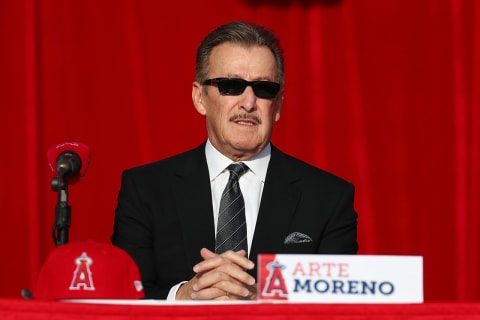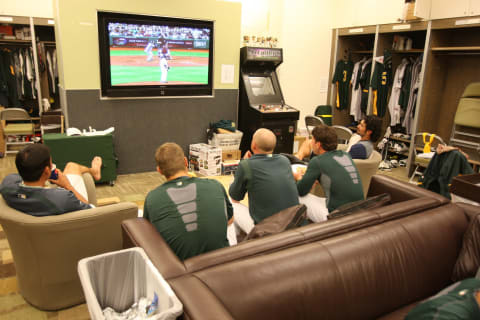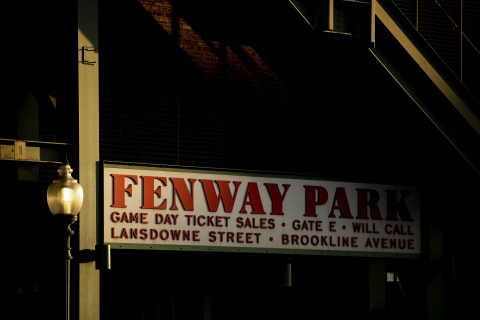2020 MLB Season: Through the owners perspective


Owners of the richest teams might be the biggest losers of the 2020 MLB season.
Put yourself in the shoes of team owners. How badly do you want to play the 2020 MLB season?
Since owners are business people, this is fundamentally a financial question. In a normal year, Forbes projects that the average MLB team would gross about $345 million, and be left with about $50 million in playing-around money once the essentials are dealt with.
More from Call to the Pen
- Philadelphia Phillies, ready for a stretch run, bomb St. Louis Cardinals
- Philadelphia Phillies: The 4 players on the franchise’s Mount Rushmore
- Boston Red Sox fans should be upset over Mookie Betts’ comment
- Analyzing the Boston Red Sox trade for Dave Henderson and Spike Owen
- 2023 MLB postseason likely to have a strange look without Yankees, Red Sox, Cardinals
But 2020 is not a normal year, and while nobody – including you or me – is quite sure how much revenues are going to take a hit, it’s certain to be a substantial one. The MLBPA is now proposing a longer season, which would increase owners’ expenses by pro-rating player salaries over a larger number of games.
And while owners might – probably would –recoup some of that via increased media value – nobody’s going out of the house these days so ratings should be good – you can basically write off ticket sales, parking, concessions and a substantial portion of normal brand sales…since nobody’s buying stuff, either.
Owners are reportedly poised to make a counter-offer involving a shorter 50-game season with pro-rated salaries. Since fewer games means less pay, the Players Union is expected to react unfavorably.
How much do owners stand to lose, and how badly do they want to play if it means losing that?
Related Story. 2020 MLB Season: The toughest in new proposal? No spitting. light
Those are the questions owners are wrestling with right now as they consider how to respond to the latest players’ proposal. And because the 30 club owners represent widely divergent perspectives and face equally divergent revenue projections if games are played, their responses are unlikely to be anywhere as unified as the Union’s response is likely to be.
Some of the game’s poorer teams – whose revenue derives largely from their share of national media – are relatively insulated from the financial impact of a shortened, no-fans season. Conversely the game’s richer teams, those whose valuation is more weighted toward market-generated revenues – those in the greatest jeopardy – may have the least incentive to take the field at all.
What follows is an analysis of the owners’ perspective of the negotiations. We’re going to look at where team revenues tend to come from, how much they are likely to be impacted assuming games are played, and we’ll also look at the diversity of those impacts.

For the 2020 MLB season, or any season, where does money come from?
An MLB team – any major pro sports entity really – has four broad sources of revenue. Those four are:
1. Sport-wide revenue sharing. This is generally money generated by national network media rights and distributed league-wide based on a pre-determined formula. Amounts vary, but in a normal year Forbes Magazine – the best reference point for such data — estimates that teams could expect to average about $368 million from this source.
For owners of small-market teams, this is an indispensable source of revenue, averaging 37 percent of a team’s normal value, and up to 70 percent for ultra-poor teams such as the Miami Marlins. Fortunately, national media is probably the most secure revenue source in the event games are played, since it tends to be playoff-loaded, and those games would be protected first.
2. Market. The largest and most successful teams rely heavily on local market revenues. Forbes estimates that the New York Yankees, the largest and most successful franchise in the game, derive nearly half their overall value from their market. The MLB-wide average is about 30 percent.
The term, by the way, basically encompasses local media and ticket sales. Ticket sales are almost guaranteed to be wiped out in 2020, leaving local media as the predominant source of market revenue. That’s a substantial hit to the game’s richest teams.
3. Stadium revenues. Stadium revenues are those revenues ancillary to ticket sales but tied directly to the facility itself. The two chief categories of stadium revenues are parking and concessions. Several teams also derive revenues from the rental of the stadium for concerts or linked to stadium-area developmental deals.
On average, stadium revenues amount to about 16 percent of a team’s overall revenues, and they are virtually guaranteed to be eliminated in 2020.
4. Brand. This is the money a team gains from the sale of licensed merchandise related to the team’s brand. In a normal year, brand revenue accounts for about 11 percent of team revenue, and the variations are small. This year, given the decreased economic activity in general, those revenues are likely to take a big hit.

How big of a hit are teams taking for the 2020 MLB season, really?
Since MLB team revenue statements are privately held, the best we can do is estimate them. Indeed that’s one of the major gripes of the Players Union, which is suspicious of the numbers proffered by the owners. That’s fair, and since owners are unlikely to make their actual revenues private it is not likely to change. What follows, then, is an estimate.
I’m also estimating one other unknowable because it is necessary to do so in order to create a starting point. That is the extent of the expected decrease in each revenue source.
Again, it is likely that not even a skilled economist has more than a guess at the projected reductions. The estimates I am using – which are mine and can be argued with – are as follows:
1. Sport-wide revenue sharing: 85 percent of normal. Some impact on national media has to be expected given the number of games canceled, but that would be offset to some significant extent by the playing of an expanded post-season.
2. Market revenue: 20 percent of normal. Without fans, market revenue is essentially reduced to local media.
3. Stadium revenue: 5 percent of normal. No fans means no parking, no concessions, and likely no facility rental. Those teams with ongoing real estate deals will reap some value from them. Some, however, will be zeroed out of this category.
4. Brand revenue: 40 percent of normal. This is largely driven by the general economic downturn, plus the suspicion that fans will view officially licensed gear as a frill purchase rather than a necessity.

What does it mean for teams during the 2020 MLB season?
The financial impact will vary depending on where the team usually gets its revenue. But here’s the bottom line: Buying the assumptions as stated above, the average Major League team could expect to reap $144 million in operating revenues assuming half a 2020 MLB season is played. That is a 56 percent reduction from the normal $345 million.
For traditionally lower-revenue teams, this may actually be less of a big deal. The Marlins, for instance, originally expected to take in $222 million in revenues. Since such a large portion (70 percent) of their revenue profile is linked to sport-wide revenue sharing – which should be the safest revenue stream – the Marlins could project to see their operating revenues decline only 35 percent, to $145 million.
Other teams fitting this same general profile include those thought of as the game’s poorer children: the Oakland Athletics, Cincinnati Reds, Kansas City Royals, Tampa Bay Rays and Baltimore Orioles.
Without exception those teams, all dependent on league-wide revenue sharing — could expect to take in at least half and probably more of the revenues they would normally have received during an uneventful 2020.
Since the game’s poorest teams generally occupy the smallest markets, they are thus are more insulated from the areas of greatest financial turmoil: ticket sales and ancillary stadium revenues. On average those teams normally expect to reap only about 25 percent of their overall revenues from those most-in-jeopardy sources.

What’s the other side of the coin, especially for the 2020 MLB season?
It’s a different story for teams annually generating the largest proportion of revenues from market and stadium sources. Forbes has found that of the 10 richest teams in terms of valuation, nine are also among the 10 most reliant on market revenues. (The San Francisco Giants are the exception.) Those nine – the Yankees, Dodgers, Red Sox, Cubs, Angels, Phillies, Astros, Braves and Cardinals – project 2020 revenue declines to just over one-third of normal if a half-season is played without fans.
While it’s always hard to pity the Yankees, they are in some aspects the poster child for this disparity. During a normal season, the Yankees only project to receive about $103 million in sport-wide revenue sharing, so the relative shield under which that revenue source operates actually helps them less than any other team. For the record, most of the league’s richest teams also project to receive about that same $103 million amount.
At an 85 percent protection level, those teams still derive about $88 million from sport-wide revenue sharing.
But look what happens to market and stadium revenues. Those are normally far and away from the Yankees’ largest revenue sources, amounting to about $315 million and $148 million respectively. Reduce those shares to the formularized 20 percent and 5 percent and it amounts to a combined $70 million as opposed to $463 million.
Again, these figures are estimates. Teams such as the Yankees may be helped by their ownership of their own local market network. But the broad consequences, if imprecise, remain unavoidable.
For the richest teams, the projected bottom line is dis-incentivizing. Based on these assumptions, the Yankees project to make only about 30 percent of their normal projected revenue in 2020, likely not near enough to cover the expenses of playing half a season. Here are the projections for the game’s other richest teams:
- Dodgers: 33 percent
- Red Sox: 34 percent
- Cubs: 35 percent
- Astros: 35 percent
- Phillies: 37 percent
- Cardinals: 37 percent
- Braves: 38 percent
- Angels: 38 percent
- Nationals: 38 percent
- Mets: 38 percent

Conclusion
It is emotionally uplifting to look past data of this sort to the potential damage done to a teetering fan base and call on owners to rise above profit for the sake of principle. After all, even in a worst-case scenario outlined above, the Yankees still emerge with $205 million in operating revenue. If that results in a one-year operating loss, well, lots of people are losing money this year.
More from MLB News
- MLB Power Rankings: Atlanta Braves still on top with major shifting below them
- Caesars MLB Promo Code: Two Shots at Picking the World Series Winner!
- MLB Power Rankings: Atlanta Braves still on top amid a big shake-up in top 10
- DraftKings MLB Promo: Bet $5 on an Anytime Home Run, Win $150 Bonus GUARANTEED
- MLB Power Rankings: After MLB trade deadline, gap is closing on Atlanta Braves
I sympathize with, and as a fan share that sentiment.
But from a business standpoint, it is also possible that a significant block of MLB owners look at the projected team bottom lines and conclude that coming back makes at most questionable fiscal sense if it makes any sense at all.
It may be better, from their standpoint, to write off 2020, cut losses and look ahead. That may be what is driving their position in the developing standoff with the players union.
This does assume, of course, something that is not in evidence: namely the actual dollars-and-cents projections on a team-by-team basis. When the Union expresses its distrust of ownership claims, that has to be recognized as a valid concern.
Next. Yankees: taking a moment to appreciate Lou Gehrig. dark
It is one thing, however, to distrust ownership claims, and another to act on the presumption that those claims are false. Many of the aspects of these negotiations are based on presumptions or assumptions, not least of which is exactly what will happen to media revenues during an expanded post-season pushed later and later into an equally sensitive NFL season.